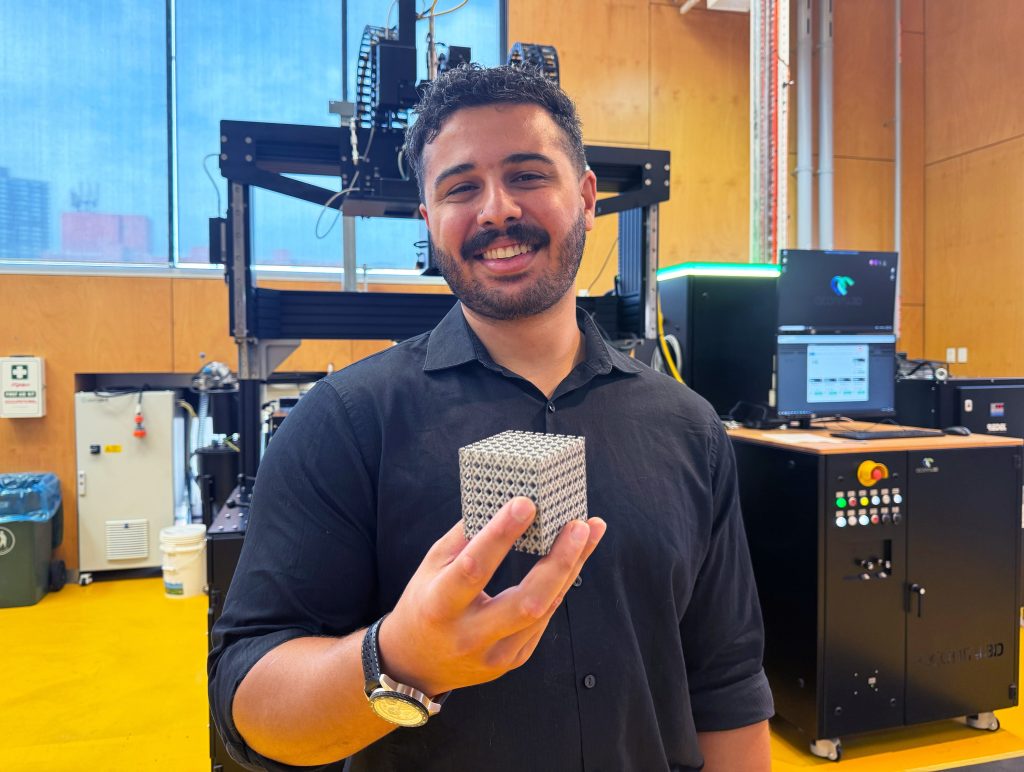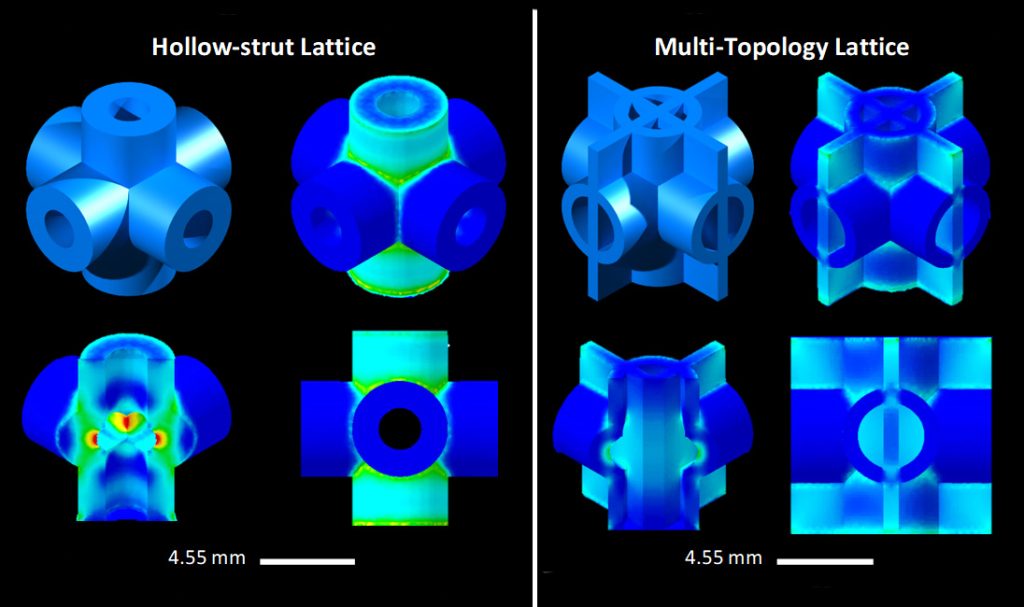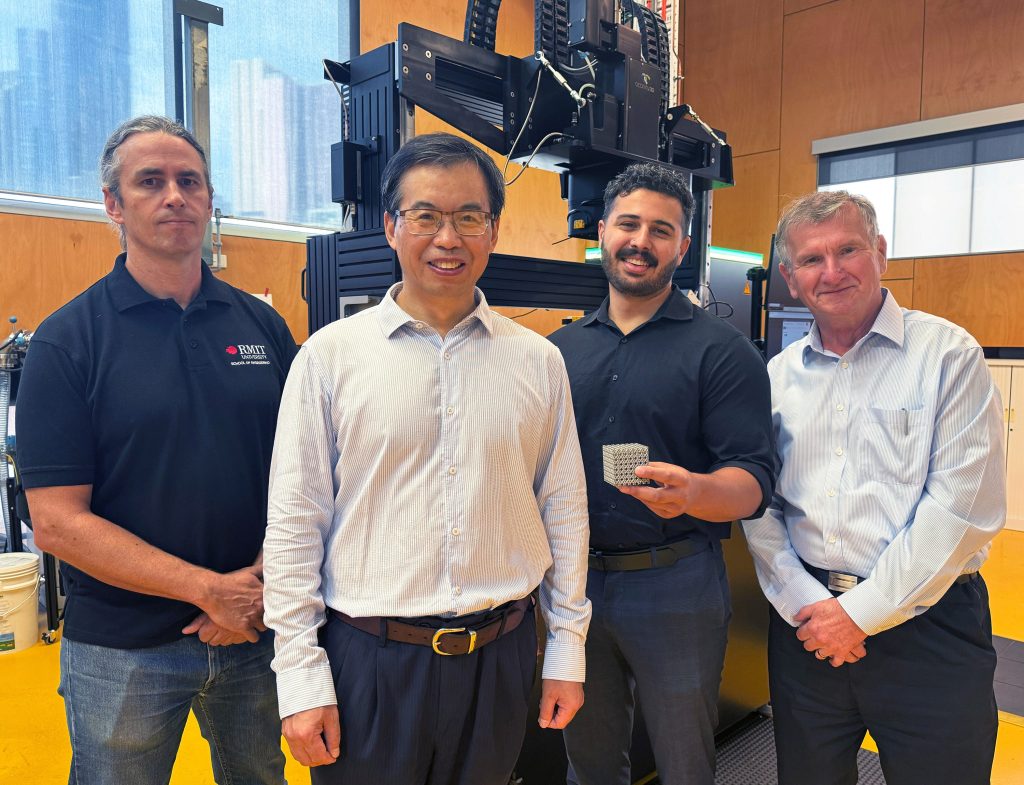Researchers from RMIT University have 3D printed a titanium structure that is 50% stronger than the strongest alloy with similar density developed for aerospace applications.
The high-strength structure is a “metamaterial,” an artificial, cellular material specially engineered to possess unique mechanical and multifunctional properties.
The RMIT team’s artificial, multi-topology metamaterial was created using the common titanium alloy Ti-6Al-4V, and features a unique hollow-strut lattice (HLS) design. This enables high strength with minimal weight.
Previously, the production of these ultra-strong lattices has been impeded by manufacturability limitations and load stress concentrating on the interior of the hollow struts. These challenges have now been overcome by the scientists’ additive manufacturing-driven approach.
Produced through powder bed fusion (PBF), the new 3D printing-optimized hollow-strut lattice (HLS) structure has been designed to evenly distribute load stress, enhancing its strength and structural efficiency. This has been achieved by combining two complementary lattice topologies into a single structure.
“We designed a hollow tubular lattice structure that has a thin band running inside it. These two elements together show strength and lightness never before seen together in nature,” explained study co-author Professor Ma Qian. “By effectively merging two complementary lattice structures to evenly distribute stress, we avoid the weak points where stress normally concentrates.”
The researchers believe that this new material could offer value in a range of applications, including in the production of medical implants and aircraft or rocket parts.
The team’s findings, titled “Titanium Multi-Topology Metamaterials with Exceptional Strength,” have been published in the journal Advanced Materials.

New 3D printed, ultra-strong lattice structures
Lattice structures which feature hollow struts have long been recognised as being highly versatile, lightweight and strong.
However, despite extensive research, previous metal lattice metamaterials have failed to achieve mechanical properties superior to magnesium alloys at similar densities. This has limited their adoption in wider industrial applications requiring high load-bearing and heat- or corrosion-resistant properties.
The Australia-based research team’s PBF 3D printed titanium lattice cube is said to have overcome these limitations. The new metamaterial was found to be 50% stronger than cast magnesium alloy WE54, the strongest alloy of similar density used in aerospace applications. The new structure halved the amount of stress concentrated on the lattice’s weakest points.
The double lattice design further bolsters the structure’s mechanical strength, as any cracks are deflected through the entire structure.

According to the study’s lead author, RMIT PhD candidate Jordan Noronha, the new metamaterial structure can be 3D printed in a variety of sizes ranging from several millimeters to several meters. Additionally, the design can also be fabricated using different types of 3D printers.
“Compared with the strongest available cast magnesium alloy currently used in commercial applications requiring high strength and lightweight, our titanium metamaterial with a comparable density was shown to be much stronger or less susceptible to permanent shape change under compressive loading, not to mention more feasible to manufacture,” commented Noronha.
Not just ultra-strong, the 3D printable lattice structure also features biocompatibility, corrosion and heat resistance to temperatures as high as 350°C. This reportedly makes it a promising candidate for numerous applications, including bone implants and key aerospace components.
Looking to the future, the RMIT team plans to further optimize the metamaterial to improve its efficiency and explore applications in higher-temperature environments. The researchers believe the material could be adapted to withstand up to 600°C by using more heat-resistant titanium alloys, ideal for the production of firefighting drones.
Noronha added that, as PBF technology becomes more accessible and 3D print speeds increase, more companies will look to implement these high-strength multi-topology metamaterials into their components.

Developments in 3D printed metal lattices
The RMIT researchers are not the first to explore the role of 3D printing in the production of highly durable metal lattices.
Researchers from the University of Sheffield and Imperial College London (ICL) have previously developed 3D printed crystal-inspired metamaterials which offer high durability and damage tolerance.
The 3D printed ‘meta-crystals’ featured novel lattice compositions which mimic the ultra-strong internal structure of crystals. The researchers incorporated polycrystalline microstructures into their metal alloy 3D printed lattices. The end goal of this research was the production of robust and damage-tolerant materials.
Following experimental testing, the researchers found that the 3D printed parts were highly energy absorbent. The 3D printed parts were able to withstand seven times more energy than materials which mimic single-crystal structures.
Elsewhere, RWTH Aachen University’s Digital Additive Production facility (DAP) is researching a new zinc-magnesium alloy combination for lattice structures as part of the BioStruct project.
The DAP team is using laser beam powder bed fusion (LB-PBF) to 3D print the lattices, which offer the potential for the production of bioresorbable bone implants. The 3D printing process has reportedly opened up new design possibilities for the production of implants which meet patient-specific needs, such as mechanical stress and corrosion behavior at the application site.
Subscribe to the 3D Printing Industry newsletter to keep up to date with the latest 3D printing news. You can also follow us on Twitter, like our Facebook page, and subscribe to the 3D Printing Industry Youtube channel to access more exclusive content.
Are you interested in working in the additive manufacturing industry? Visit 3D Printing Jobs to view a selection of available roles and kickstart your career.
Featured image shows PhD candidate Jordan Noronha holding a sample of the new titanium lattice structure 3D printed in cube form. Photo via RMIT.

